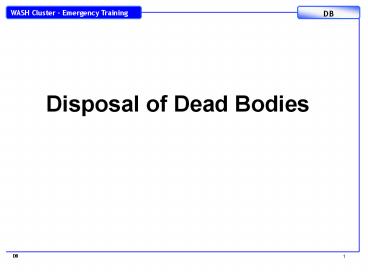Disposal of Dead Bodies PowerPoint PPT Presentation
1 / 23
Title: Disposal of Dead Bodies
1
Disposal of Dead Bodies
2
Introduction and Objective Setting
3
Overall Objective
- To put the issue of dead bodies into a public
health perspective (including psycho-social
aspects) and understand the basics of managing
dead bodies in the first phase following a
disaster.
4
Specific Objectives
- Describe the relative importance of dead bodies
in an emergency (health risks to the public and
those handling the dead) - Develop an action plan to manage dead bodies in a
practical sense following a disaster - List 3 extra precautions needed in dealing with
those who have died from a highly infectious
disease such as cholera or Ebola.
5
Public Health Importance of Dead Bodies?
6
General Discussion
- Question to group
- Is the disposal of the dead a major public health
priority in the aftermath of a disaster?
7
General Discussion
- Dead bodies do not cause epidemics
- Source PAHO et al, Management of Dead Bodies
after Disasters A field manual for first
responders, 2006
8
General Discussion
- Question to group
- Having established that in general dead bodies do
not pose a major physical public health risk what
are the implications of action or inaction with
regard to mental health?
9
General Discussion
- Burials in common graves and mass cremations are
rarely warranted and should be avoided - Source Dispoal of Dead Bodies in emergency
conditions - WHO, Technical Note No.8, Draft revised 7.1.05
10
General Discussion
- Question to group
- If you have responsibility for the collection of
corpses following an earthquake what are the
infectious disease risks for those staff (body
handlers) employed to undertake this task?
11
Infectious Disease Risks
- Risk to body handlers
- Hepatitis B and C
- HIV
- Tuberculosis
- Diarrhoeal disease
12
Group Work
- Group to be divided into groups of four people to
address the following scenario. - 20 mins to review the scenario and develop an
action plan - 10 mins thereafter to present back.
13
Group Work
- An earthquake has struck a large city in a part
of South East Asia at the height of the hot
season. The majority of the population are
Christian. Approximately 20,000 people have died
as a direct result of the earthquake. - Your agency has been delegated to address the
issue of dead bodies. - Describe what you would do in this situation?
14
Group Work
- Issues that you should have addressed include-
- Body Recovery
- Storage of Dead Bodies
- Identification of Dead Bodies
- Information Management
- Disposal
- Communications and the Media
- Support to Families and Relatives
15
Protecting Staff
- Key aspects to protecting staff
- Provide personal protective equipment heavy duty
gloves and boots
- Hand washing facilities with soap and water for
after handling dead bodies, - First aid available for team members and tetanus
vaccination for workers without vaccination
cover.
16
Disposal
- Question to group
- What is the preferred method of disposal for dead
bodies?
17
Burial Sites
- Question to group
- What are the criteria to consider in the
selection of an appropriate burial site?
18
Infectious Dead
- Question to group
- What special precautions would you consider
necessary in dealing with those who have died
from a highly infectious disease such as cholera?
- Example - Goma, Zaire now DRC, July 1994 Over
45,000 people died over a 3 week period from
cholera and over 90 of those died outside a
health facility.
19
Infectious Dead
- Extra precautions might include-
- Extra personal protective equipment
- The use of body bags at all times
- The disinfection of the body with a 2 chlorine
solution - Immediate burial
20
Management of Dead Bodies
- Key recommendations
- Give priority to the living (e.g. provide
sanitation facilities for the survivors first) - Promote the identification and tagging of corpses
- Provide accurate information concerning the risks
associated with corpses - Do not promote mass burial of unidentified bodies
in large graves - Conserve fuel and resources
- Respect the wishes and social customs of the
families - Source Emergency Sanitation, WEDC, 2002
21
Have Objectives been met?
- To understand the relative importance of dead
bodies in an emergency (health risks to the
public and those handling the dead) - To understand how to manage dead bodies in a
practical sense following a disaster - To understand the extra precautions needed in
dealing with those who have died from a highly
infectious disease such as cholera or ebola.
22
Have Objectives been met?
- To put the issue of dead bodies into a public
health perspective (including psycho-social
aspects) and understand the basics of managing
dead bodies in the first phase following a
disaster.
23
Key References
- Davis, Jan., and Lambert, Robert., Engineering in
Emergencies, A practical guide for relief
workers. 2nd Edition, RedR/IT, 2002 (Pg 182-183) - Disposal of Dead Bodies in emergency conditions,
WHO, Technical Note No. 8 Draft Revised 7.1.05 - PAHO et al, Management of Dead Bodies after
Disasters A field manual for first responders,
2006
- MSF, Infection Control in Health Care Settings,
First Edition, 2006. - Harvey, Peter., Baghri, Sohrab., and Reed, Bob.,
Emergency Sanitation, Assessment and Programme
Design, WEDC, Loughborough University 2002 - UNHCR, Handbook for Emergencies, Third Edition,
February 2007. (Pg 277) - Davis, Jan., and Lambert, Robert., Engineering in
Emergencies, A practical guide for relief
workers. 2nd Edition, RedR/IT, 2002 (Pg 182-183) - Disposal of Dead Bodies in emergency conditions,
WHO, Technical Note No. 8 Draft Revised 7.1.05

